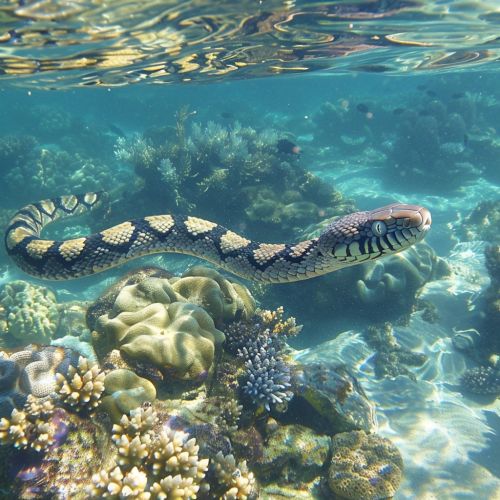Sea Snake: Difference between revisions
(Created page with "== Introduction == Sea snakes, also known as coral reef snakes, are a subfamily (Hydrophiinae) of venomous elapid snakes that inhabit marine environments. These reptiles are highly adapted to life in the ocean, exhibiting a range of physiological and behavioral traits that facilitate their survival in aquatic habitats. Sea snakes are found primarily in the warm coastal waters of the Indian and Pacific Oceans. == Taxonomy and Classification == Sea snakes belong to the fa...") |
No edit summary |
||
| Line 13: | Line 13: | ||
* **Salt excretion**: Specialized glands located under the tongue excrete excess salt, a crucial adaptation for living in saline environments. | * **Salt excretion**: Specialized glands located under the tongue excrete excess salt, a crucial adaptation for living in saline environments. | ||
[[Image:Detail-79367.jpg|thumb|center|A sea snake swimming in clear blue water, with a coral reef in the background.]] | |||
== Venom and Feeding == | == Venom and Feeding == | ||
Revision as of 06:09, 18 May 2024
Introduction
Sea snakes, also known as coral reef snakes, are a subfamily (Hydrophiinae) of venomous elapid snakes that inhabit marine environments. These reptiles are highly adapted to life in the ocean, exhibiting a range of physiological and behavioral traits that facilitate their survival in aquatic habitats. Sea snakes are found primarily in the warm coastal waters of the Indian and Pacific Oceans.
Taxonomy and Classification
Sea snakes belong to the family Elapidae, which also includes terrestrial snakes such as cobras and mambas. The subfamily Hydrophiinae is further divided into two groups: the true sea snakes (Hydrophiini) and the sea kraits (Laticaudini). True sea snakes are fully aquatic and give birth to live young, while sea kraits are semi-aquatic and lay eggs on land.
Morphology and Adaptations
Sea snakes exhibit several morphological adaptations that enable them to thrive in marine environments. These include:
- **Paddle-like tails**: Sea snakes possess laterally compressed tails that function as paddles, aiding in swimming.
- **Nasal valves**: Their nostrils are equipped with valves that close when the snake is submerged, preventing water from entering the respiratory system.
- **Lung structure**: Sea snakes have elongated lungs that extend through much of their body, allowing for efficient oxygen storage and buoyancy control.
- **Salt excretion**: Specialized glands located under the tongue excrete excess salt, a crucial adaptation for living in saline environments.

Venom and Feeding
Sea snakes are highly venomous, with venom compositions that vary among species. Their venom contains neurotoxins and myotoxins, which can cause paralysis and muscle damage. Despite their potent venom, sea snakes are generally not aggressive towards humans.
Sea snakes primarily feed on fish and eels. Their hunting strategies include ambush predation and active foraging. Some species have specialized diets; for example, the yellow-lipped sea krait (Laticauda colubrina) primarily preys on eels.
Reproduction and Life Cycle
Reproductive strategies among sea snakes differ between true sea snakes and sea kraits. True sea snakes are ovoviviparous, giving birth to live young in the water. Females typically give birth to between 2 and 20 offspring, depending on the species.
Sea kraits, on the other hand, are oviparous and lay eggs on land. After mating, females come ashore to lay their eggs in crevices or burrows. The eggs hatch after an incubation period of several weeks.
Habitat and Distribution
Sea snakes are predominantly found in the warm coastal waters of the Indian and Pacific Oceans. They inhabit a range of marine environments, including coral reefs, estuaries, and mangroves. Some species, such as the yellow-bellied sea snake, are pelagic and can be found in open ocean waters.
Behavior and Ecology
Sea snakes exhibit a variety of behaviors that are adapted to their aquatic lifestyle. These include:
- **Breathing and diving**: Sea snakes can remain submerged for extended periods, typically between 30 minutes to 2 hours, depending on the species. They surface periodically to breathe.
- **Thermoregulation**: Sea snakes are ectothermic and rely on external sources of heat to regulate their body temperature. They often bask at the water's surface to absorb heat from the sun.
- **Social behavior**: While generally solitary, some sea snake species exhibit social behaviors such as forming aggregations during breeding seasons.
Conservation Status
The conservation status of sea snakes varies among species. Some species are considered to be of least concern, while others are threatened by habitat destruction, pollution, and bycatch in fishing operations. Conservation efforts focus on habitat protection, reducing bycatch, and raising awareness about the ecological importance of sea snakes.
